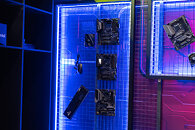- Joined
- Oct 9, 2007
- Messages
- 47,631 (7.44/day)
- Location
- Dublin, Ireland
| System Name | RBMK-1000 |
|---|---|
| Processor | AMD Ryzen 7 5700G |
| Motherboard | Gigabyte B550 AORUS Elite V2 |
| Cooling | DeepCool Gammax L240 V2 |
| Memory | 2x 16GB DDR4-3200 |
| Video Card(s) | Galax RTX 4070 Ti EX |
| Storage | Samsung 990 1TB |
| Display(s) | BenQ 1440p 60 Hz 27-inch |
| Case | Corsair Carbide 100R |
| Audio Device(s) | ASUS SupremeFX S1220A |
| Power Supply | Cooler Master MWE Gold 650W |
| Mouse | ASUS ROG Strix Impact |
| Keyboard | Gamdias Hermes E2 |
| Software | Windows 11 Pro |
At a media event in China, MSI unveiled a handful new products it hasn't yet launched globally. These include the ATX MEG Z590 Unify series, and the new Spatium line of high-end M.2 NVMe SSDs. The company already launched the MEG Z590I Unify Mini-ITX motherboard, which will soon be joined by the larger MEG Z590 Unify and the MEG Z590 Unify-X, in the standard ATX form-factor. Both these Unify motherboards are targeted at professional overclockers, and are armed with powerful 16+2 phase CPU VRM solutions that use 90 A DrMOS, 8-layer PCBs, a trio of PCIe Gen 4 M.2 slots (possibly using PCIe segmentation of the x16 PEG slot); and the company's latest Audio Boost 5 onboard audio solution.
What sets the MEG Z590 Unify apart from the Unify-X is that the latter features just two DDR4 DIMM slots, or one DIMM per memory channel. This is the most desirable topology for memory overclocking (and a reason why memory OC records are usually set on Mini-ITX motherboards). Next up, the company unveiled the Spatium series of high-end M.2 NVMe SSDs. Available with a number of heatsink (options?), these drives take advantage of PCI-Express 4.0 x4 host interface, and come in capacities of up to 4 TB. They use 3D TLC NAND flash, and offer sequential transfer rates of up to 7000 MB/s reads, with up to 6900 MB/s writes.




View at TechPowerUp Main Site
What sets the MEG Z590 Unify apart from the Unify-X is that the latter features just two DDR4 DIMM slots, or one DIMM per memory channel. This is the most desirable topology for memory overclocking (and a reason why memory OC records are usually set on Mini-ITX motherboards). Next up, the company unveiled the Spatium series of high-end M.2 NVMe SSDs. Available with a number of heatsink (options?), these drives take advantage of PCI-Express 4.0 x4 host interface, and come in capacities of up to 4 TB. They use 3D TLC NAND flash, and offer sequential transfer rates of up to 7000 MB/s reads, with up to 6900 MB/s writes.




View at TechPowerUp Main Site

